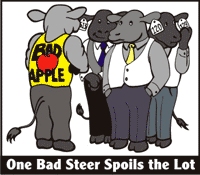
Kris Ringwall
Beef Talk
One bad steer spoils the lot.
The interest in age and source verification continues. The interest is real and the need is real.
As those who are involved in the process of selling beef know, once a commitment is made, that commitment needs to be honored. With the tight supplies of beef and the need to plan long term, kinks in the supply chain can make for some very long days.
Perhaps that is why the process of age and source verification continues to evolve and, much like fine wine, needs to age awhile. Not that making wine is like raising beef, but the thought process that goes with the long-term distribution of a product and the assurance of meeting the desired specifications upon arrival at the customer are no different.
Perhaps that saying of "one bad apple spoils the barrel" has a lot of take-home meaning today. Historically, storing fruit was only better when good fruit was stored. As fruit was removed from storage, spoilage was more likely centered around one bad fruit that spread the spoilage to other fruit.
 A trip to the refrigerator will confirm the concept. Whether raspberries, strawberries or other fruits, the first spoilage will be clustered around one fruit. Just as one bad apple spoils the barrel, one bad steer spoils the lot. Perhaps one should repeat that phrase — one bad steer spoils the lot.
A trip to the refrigerator will confirm the concept. Whether raspberries, strawberries or other fruits, the first spoilage will be clustered around one fruit. Just as one bad apple spoils the barrel, one bad steer spoils the lot. Perhaps one should repeat that phrase — one bad steer spoils the lot.
When cattle are sold, they are grouped into desirable lots that are projected to meet the specifications of the customer. It is the grouping into the lots that causes the challenge when beef producers age- and source-verify their cattle. The process is simple, but once the cattle are grouped, the verification and authentication of the group brings challenges.
The concept is not new; however, in the past the beef industry has not handled the simultaneous sale of cattle and data. Data, which is the verification of the cattle contained in the group, needs to remain with the cattle from the first purchase transaction to the last transaction.
The North Dakota Beef Cattle Improvement Association (NDBCIA) will age- and source-verify cattle within the program. The process is simple at the start, but it soon gets complicated.
Originally, the primary failure to maintain age and source verification and conform to the program was the removal of the tag and subsequent commingling of the cattle. As a ballpark estimate for the cattle the Dickinson Research Extension Center tracked, only one tagged calf out of five reached the point of harvest with all the data attached. However, not all of those cattle were intended to meet the specifications for age and source verification.
As market incentives increase, there are more cattle being sold that meet age and source verification. The producers, feeders and packers are working diligently to pull cattle through a market channel that only maintained data connectivity for one out five calves, if the previous tracing at the center was used as the estimate. For these producers, feeders and packers, the effort is paying off, but not without some headaches.
The lesson is coming through very clearly that one bad steer spoils the lot. The problem is fixable, but the real problem is cattle lots do not hold true.
The producer knows well that pastured cattle do not always remain in the pasture where they were placed. In fact, more times than not, when the crew gets done working cattle, there still remains a cow or two, maybe their calves and even a bull, that do not belong to the center.
 The cattle are returned to the right owner. Feedlots are not immune to misplaced cattle, either. "Who did not latch the gate?" "He's going to jump." "I have no idea of how that calf got in that pen." These are well-known expressions as people handle cattle.
The cattle are returned to the right owner. Feedlots are not immune to misplaced cattle, either. "Who did not latch the gate?" "He's going to jump." "I have no idea of how that calf got in that pen." These are well-known expressions as people handle cattle.
Even more, as the calves come through the chutes, the "no tag" cry is heard. Where did the tag go?
It's a busy day with lots of cattle to work, but the cattle continue to be processed. However, in today's world of age and source verification, "one bad steer can spoil the lot" means processing needs to be thorough and not held off until shipping day.
The beef business is no different than the fruit, grape or any other business that demands perfection. Sort before you package, sort upon arrival and, most certainly, sort before the steers get on the truck for harvest.




